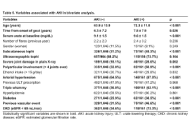

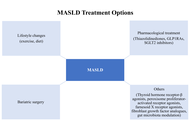



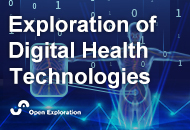

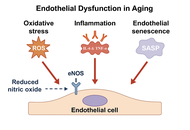

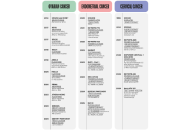
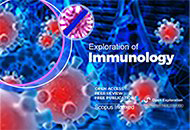

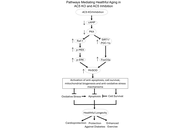

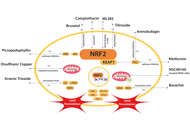
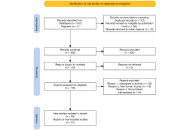
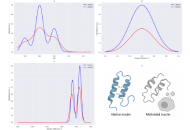
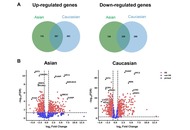


Aim:
To compare the rate of acute kidney injury (AKI) associated with non-steroidal anti-inflammatory drugs (NSAIDs) through two consecutive decades in patients with gout and to study factors associated with AKI events.
Methods:
Retrospective analysis of data from Jan 1994 to Dec 2024. Data on AKI and upper gastrointestinal bleeding (UGB) were collected during the same period (2005–2024), along with general (age, gender, time from onset), gout-related (tophi, imaging, clinical distribution, number of flares), treatment-related (diuretic and urate-lowering medications, exposure to the triple whammy), and comorbidities-related variables (hypertension, hyperlipidemia, diabetes, chronic kidney disease). Analysis was made for the whole cohort and comparing decades with each other. Survival analysis was performed to evaluate those variables independently associated with a higher risk of AKI.
Results:
1,207 cases were available for analysis. The overall cumulated rate of AKI was 13.3%, showing an increase from 9.9% to 16.1% from the first to the second decades, respectively, but no change in the severity of AKI was observed. In contrast, there was no change in the rate of UGB through the two decades (close to 2%). There was an increase in the frequency of gout severity variables, triple whammy exposure, and comorbid conditions through the two decades. Age, tophaceous gout, chronic kidney disease, triple whammy exposure, were variables independently associated with a higher risk of AKI, while urate-lowering prescription was associated with a lower risk.
Conclusions:
An increase in the rate of AKI was observed through the two decades studied, associated with an increase in gout severity, comorbidity, and exposure to triple whammy. Chronic kidney disease and exposure to triple whammy in older patients with severe (tophaceous) gout seem to define the combination for the highest risk, in whom the avoidance of NSAIDs should be carefully considered.
Aim:
To compare the rate of acute kidney injury (AKI) associated with non-steroidal anti-inflammatory drugs (NSAIDs) through two consecutive decades in patients with gout and to study factors associated with AKI events.
Methods:
Retrospective analysis of data from Jan 1994 to Dec 2024. Data on AKI and upper gastrointestinal bleeding (UGB) were collected during the same period (2005–2024), along with general (age, gender, time from onset), gout-related (tophi, imaging, clinical distribution, number of flares), treatment-related (diuretic and urate-lowering medications, exposure to the triple whammy), and comorbidities-related variables (hypertension, hyperlipidemia, diabetes, chronic kidney disease). Analysis was made for the whole cohort and comparing decades with each other. Survival analysis was performed to evaluate those variables independently associated with a higher risk of AKI.
Results:
1,207 cases were available for analysis. The overall cumulated rate of AKI was 13.3%, showing an increase from 9.9% to 16.1% from the first to the second decades, respectively, but no change in the severity of AKI was observed. In contrast, there was no change in the rate of UGB through the two decades (close to 2%). There was an increase in the frequency of gout severity variables, triple whammy exposure, and comorbid conditions through the two decades. Age, tophaceous gout, chronic kidney disease, triple whammy exposure, were variables independently associated with a higher risk of AKI, while urate-lowering prescription was associated with a lower risk.
Conclusions:
An increase in the rate of AKI was observed through the two decades studied, associated with an increase in gout severity, comorbidity, and exposure to triple whammy. Chronic kidney disease and exposure to triple whammy in older patients with severe (tophaceous) gout seem to define the combination for the highest risk, in whom the avoidance of NSAIDs should be carefully considered.
DOI: https://doi.org/10.37349/emd.2025.1007107
This article belongs to the special issue Evaluation and Outcomes in the Management of Gout

Cancer is one of the leading global causes of mortality and morbidity, so it needs early diagnosis and therapies. Traditional diagnostic and therapeutic strategies are inadequate due to several limitations, such as poor specificity, systemic toxicity, and delays, while metal-grafted Gr nanostructures have emerged as promising theranostic platforms due to their unique electronic, optical, and structural properties. Metals such as Fe3O4, Au, Ag, TiO2, Pd, Pt, Bi, ZnO, and Cu grafted onto the Gr surface impart electronic modulation, enhance surface area, flexibility, conductivity, reactivity, biomolecular interactions, and biosensing, thereby enabling precise biomarker detection, targeted drug delivery, imaging, and photothermal/photodynamic therapy (PTT/PDT). Eco-friendly synthesis using plant extracts and microbes offers a sustainable and biocompatible alternative to conventional chemical synthesis. However, challenges remain, such as homogenous doping, synthetic complexity, long-term safety, and clinical scalability. Innovations such as scalable, cost-effective, biocompatible nanofibers, nanopapers, microfluidic, and wearable biosensors are being explored by incorporating AI and advanced diagnostic tools for advanced biomedical devices. In vitro, half maximum inhibitory concentrations (IC50) studies show that size- and dose-dependent nanohybrids such as Fe3O4-Gr, γ-Fe2O3-Gr, Au-Gr, and Bi-Gr exhibited safer responses at lower concentrations 10–200 µg/mL across HBE, MCF-7, HeLa B, and LNCaP cell lines. Bi-Gr was tested on human liver cancer (HepG2) cell line, which exhibits higher reactivity despite a safer profile of Bi at ~53–88 µg/mL. Pd-Gr and Pt-Gr significantly reduced viability in prostate and ovarian cancer cells at 10–50 µg/mL, while ZnO-Gr, Ag-Gr, and Cu-Gr showed safer activity at lower concentrations on MCF-7. In vivo studies remain limited; median lethal dose (LD50) values for Fe3O4-Gr and γ-Fe2O3-Gr were determined to be associated with rapid lethal biodistribution observed in the liver, lungs, and spleen. Metal-grafted Gr nanohybrids demonstrate immense potential for multifunctional cancer theranostics, though systematic in vivo toxicity studies still need to be explored by the intravenously administered route to lower the LD50 of nanohybrids for their clinical translation.
Cancer is one of the leading global causes of mortality and morbidity, so it needs early diagnosis and therapies. Traditional diagnostic and therapeutic strategies are inadequate due to several limitations, such as poor specificity, systemic toxicity, and delays, while metal-grafted Gr nanostructures have emerged as promising theranostic platforms due to their unique electronic, optical, and structural properties. Metals such as Fe3O4, Au, Ag, TiO2, Pd, Pt, Bi, ZnO, and Cu grafted onto the Gr surface impart electronic modulation, enhance surface area, flexibility, conductivity, reactivity, biomolecular interactions, and biosensing, thereby enabling precise biomarker detection, targeted drug delivery, imaging, and photothermal/photodynamic therapy (PTT/PDT). Eco-friendly synthesis using plant extracts and microbes offers a sustainable and biocompatible alternative to conventional chemical synthesis. However, challenges remain, such as homogenous doping, synthetic complexity, long-term safety, and clinical scalability. Innovations such as scalable, cost-effective, biocompatible nanofibers, nanopapers, microfluidic, and wearable biosensors are being explored by incorporating AI and advanced diagnostic tools for advanced biomedical devices. In vitro, half maximum inhibitory concentrations (IC50) studies show that size- and dose-dependent nanohybrids such as Fe3O4-Gr, γ-Fe2O3-Gr, Au-Gr, and Bi-Gr exhibited safer responses at lower concentrations 10–200 µg/mL across HBE, MCF-7, HeLa B, and LNCaP cell lines. Bi-Gr was tested on human liver cancer (HepG2) cell line, which exhibits higher reactivity despite a safer profile of Bi at ~53–88 µg/mL. Pd-Gr and Pt-Gr significantly reduced viability in prostate and ovarian cancer cells at 10–50 µg/mL, while ZnO-Gr, Ag-Gr, and Cu-Gr showed safer activity at lower concentrations on MCF-7. In vivo studies remain limited; median lethal dose (LD50) values for Fe3O4-Gr and γ-Fe2O3-Gr were determined to be associated with rapid lethal biodistribution observed in the liver, lungs, and spleen. Metal-grafted Gr nanohybrids demonstrate immense potential for multifunctional cancer theranostics, though systematic in vivo toxicity studies still need to be explored by the intravenously administered route to lower the LD50 of nanohybrids for their clinical translation.
DOI: https://doi.org/10.37349/etat.2025.1002346
This article belongs to the special issue Potential Clinical Applications of Inorganic Nanomaterials in Cancer

Fatty liver, defined as lipid accumulation in more than 5% of hepatocytes, has become an increasingly important contributor to liver cirrhosis, particularly as viral hepatitis is being brought under control through vaccination and antiviral therapies. Abdominal obesity and insulin resistance play a central role in its pathogenesis. The global burden of metabolic dysfunction-associated steatotic liver disease (MASLD), formerly known as nonalcoholic fatty liver disease (NAFLD), continues to rise in parallel with the increasing prevalence of obesity and type 2 diabetes mellitus (T2DM). While meta-analyses indicate that the overall worldwide prevalence of MASLD is approximately 30%, higher rates have been reported in regions such as Latin America and North America. Among individuals with T2DM, the prevalence may reach up to 65%, and MASLD in these patients frequently progresses to metabolic dysfunction-associated steatohepatitis (MASH) and advanced fibrosis. Shared pathogenic mechanisms—most notably insulin resistance and chronic low-grade inflammation—drive disease progression, contributing to increased morbidity and mortality. The bidirectional relationship is further underscored by the observation that MASLD itself predisposes to the development of T2DM. In addition, the coexistence of MASLD and T2DM may exert a synergistic effect on cardiovascular disease (CVD) risk, and emerging evidence suggests that MASLD may represent an independent risk factor for CVD. Consequently, individuals with both MASLD and T2DM should be recognized as a particularly high-risk population requiring comprehensive monitoring of both hepatic and cardiovascular health. In this review, we aim to provide a concise overview of the etiopathogenesis, diagnostic approaches, and therapeutic strategies related to the MASLD-T2DM interface, a global health challenge that can be regarded as a pandemic of modern times.
Fatty liver, defined as lipid accumulation in more than 5% of hepatocytes, has become an increasingly important contributor to liver cirrhosis, particularly as viral hepatitis is being brought under control through vaccination and antiviral therapies. Abdominal obesity and insulin resistance play a central role in its pathogenesis. The global burden of metabolic dysfunction-associated steatotic liver disease (MASLD), formerly known as nonalcoholic fatty liver disease (NAFLD), continues to rise in parallel with the increasing prevalence of obesity and type 2 diabetes mellitus (T2DM). While meta-analyses indicate that the overall worldwide prevalence of MASLD is approximately 30%, higher rates have been reported in regions such as Latin America and North America. Among individuals with T2DM, the prevalence may reach up to 65%, and MASLD in these patients frequently progresses to metabolic dysfunction-associated steatohepatitis (MASH) and advanced fibrosis. Shared pathogenic mechanisms—most notably insulin resistance and chronic low-grade inflammation—drive disease progression, contributing to increased morbidity and mortality. The bidirectional relationship is further underscored by the observation that MASLD itself predisposes to the development of T2DM. In addition, the coexistence of MASLD and T2DM may exert a synergistic effect on cardiovascular disease (CVD) risk, and emerging evidence suggests that MASLD may represent an independent risk factor for CVD. Consequently, individuals with both MASLD and T2DM should be recognized as a particularly high-risk population requiring comprehensive monitoring of both hepatic and cardiovascular health. In this review, we aim to provide a concise overview of the etiopathogenesis, diagnostic approaches, and therapeutic strategies related to the MASLD-T2DM interface, a global health challenge that can be regarded as a pandemic of modern times.
DOI: https://doi.org/10.37349/eemd.2025.101446
This article belongs to the special issue Current Views on Pathogenesis, Diagnosis and Management of Type 2 Diabetes Mellitus and Its Complications and Related Conditions

Aim:
To assess the burden of digital eye strain (DES) and associated factors among technology students at public universities in southern Ethiopia.
Methods:
A cross-sectional study was conducted from March to April 2024 at three universities—Hawassa, Dilla, and Jinka. Data were collected using pretested self-administered questionnaires, including the Digital Eye Strain Questionnaire and other relevant variables.
Results:
The survey tool was distributed to the total study population of 788 students, of whom 403 completed the survey, representing 93.5% of the calculated sample size of 431. Participants were predominantly male (74.7%) and enrolled at Hawassa University (57.8%). Daily digital device usage of ≥ 2 hours was reported by 259 (64.3%), and 72.7% had owned digital devices for > 2 years. Few participants reported smoking (0.7%), alcohol use (10.9%), or khat chewing (7.7%), and 13.9% had a history of accidents. Overall, 68.5% [95% confidence interval (CI): 64.0%–73.0%] experienced at least one symptom of DES in the past 12 months, with photophobia being the most common. DES was experienced more likely among students from Hawassa University [adjusted odds ratio (AOR) = 2.43; 95% CI: 1.11–5.30; p = 0.026], females (AOR = 2.32; 95% CI: 1.25–4.31; p = 0.008), current alcohol consumers (AOR = 3.12; 95% CI: 1.20–8.08; p = 0.019), and those with a history of accidents (AOR = 2.68; 95% CI: 1.17–6.13; p = 0.020).
Conclusions:
Over two-thirds of final-year technology students in southern Ethiopian universities reported at least one symptom of DES, with higher risk observed among females, alcohol users, and those with prior accidents.
Aim:
To assess the burden of digital eye strain (DES) and associated factors among technology students at public universities in southern Ethiopia.
Methods:
A cross-sectional study was conducted from March to April 2024 at three universities—Hawassa, Dilla, and Jinka. Data were collected using pretested self-administered questionnaires, including the Digital Eye Strain Questionnaire and other relevant variables.
Results:
The survey tool was distributed to the total study population of 788 students, of whom 403 completed the survey, representing 93.5% of the calculated sample size of 431. Participants were predominantly male (74.7%) and enrolled at Hawassa University (57.8%). Daily digital device usage of ≥ 2 hours was reported by 259 (64.3%), and 72.7% had owned digital devices for > 2 years. Few participants reported smoking (0.7%), alcohol use (10.9%), or khat chewing (7.7%), and 13.9% had a history of accidents. Overall, 68.5% [95% confidence interval (CI): 64.0%–73.0%] experienced at least one symptom of DES in the past 12 months, with photophobia being the most common. DES was experienced more likely among students from Hawassa University [adjusted odds ratio (AOR) = 2.43; 95% CI: 1.11–5.30; p = 0.026], females (AOR = 2.32; 95% CI: 1.25–4.31; p = 0.008), current alcohol consumers (AOR = 3.12; 95% CI: 1.20–8.08; p = 0.019), and those with a history of accidents (AOR = 2.68; 95% CI: 1.17–6.13; p = 0.020).
Conclusions:
Over two-thirds of final-year technology students in southern Ethiopian universities reported at least one symptom of DES, with higher risk observed among females, alcohol users, and those with prior accidents.
DOI: https://doi.org/10.37349/edht.2025.101173

Hormonal dysregulation plays a central role in aging, exerting a profound, multidimensional impact on quality of life. This narrative review examines the impact of hormonal changes in understanding how age-dependent alterations in key hormonal axes, specifically those related to insulin, IGF-1, cortisol, thyroid hormones, parathyroid hormone, and sex hormones, affect metabolic, musculoskeletal, cognitive, and reproductive health. Altered hormone secretion and receptor sensitivity contribute to conditions such as type 2 diabetes mellitus, osteoporosis, sarcopenia, cognitive decline, and disrupted sleep patterns. Age-related shifts in thyroid and parathyroid function, including decreased T3 conversion and elevated PTH, further compound these physiological changes. These hormonal imbalances manifest as a multidimensional burden on quality of life, encompassing physical, cognitive, and psychosocial domains, which are particularly pronounced in postmenopausal women. Emerging therapies targeting GH secretion, myostatin inhibition, heat shock proteins, and IGF-1 offer promising avenues for mitigating age-associated symptoms and improving quality of life.
Hormonal dysregulation plays a central role in aging, exerting a profound, multidimensional impact on quality of life. This narrative review examines the impact of hormonal changes in understanding how age-dependent alterations in key hormonal axes, specifically those related to insulin, IGF-1, cortisol, thyroid hormones, parathyroid hormone, and sex hormones, affect metabolic, musculoskeletal, cognitive, and reproductive health. Altered hormone secretion and receptor sensitivity contribute to conditions such as type 2 diabetes mellitus, osteoporosis, sarcopenia, cognitive decline, and disrupted sleep patterns. Age-related shifts in thyroid and parathyroid function, including decreased T3 conversion and elevated PTH, further compound these physiological changes. These hormonal imbalances manifest as a multidimensional burden on quality of life, encompassing physical, cognitive, and psychosocial domains, which are particularly pronounced in postmenopausal women. Emerging therapies targeting GH secretion, myostatin inhibition, heat shock proteins, and IGF-1 offer promising avenues for mitigating age-associated symptoms and improving quality of life.
DOI: https://doi.org/10.37349/eemd.2025.101447
This article belongs to the special issue The Fountain of Youth: Decoding the Hormonal Regulation of Aging

Aim:
Healthcare-associated infections (HAIs), especially when multidrug-resistant bacteria cause them, pose serious challenges resulting in higher healthcare expenses, increased morbidity, and higher mortality, and thus, there is a need for new antimicrobial agents. Repurposing an old drug for new applications is an important trend, and in the present study, an anti-breast cancer drug, Tamoxifen, has been screened alone and in combination with silver nanoparticles (AgNPs) synthesized using Abutilon indicum Linn. against Enterococcus faecalis, Escherichia coli, and Staphylococcus aureus, which are involved in HAIs.
Methods:
The drug and the combination were subjected to antimicrobial potential analysis and the determination of minimum inhibitory concentrations (MICs) by agar diffusion and microdilution methods. Biofilm formation assays were performed using the crystal violet method to understand biofilm prevention and eradication efficiencies. The synergism in the activities of the drug and the combination with selected antibiotics was studied using checkerboard assay, and the cytotoxic effects of the drug and the combination on L929 cells were analyzed using MTT assay.
Results:
Tamoxifen and the AgNPs showed promising antibacterial activities, and the MICs of the drug were found to be 62.5 µg/mL (E. coli), 31 µg/mL (S. aureus), and 125 µg/mL (E. faecalis). When combined with AgNPs, Tamoxifen showed a 4-fold reduction in the MIC. The drug also displayed promising antibiofilm activities as it reduced mature S. aureus biofilms by 91%, E. faecalis biofilms by 88%, and E. coli biofilms by 73%. AgNPs alone reduced 91%, 91%, and 81% of biofilms by S. aureus, E. faecalis, and E. coli, respectively, and the combination treatment revealed 92% of S. aureus, 94% of E. faecalis, and 82% of E. coli biofilm eradication at their MICs. Tamoxifen also showed synergism when combined with antibiotics—ampicillin and rifampicin and the AgNPs in combination with Tamoxifen revealed no cytotoxic effect on L929 cells at their MICs.
Conclusions:
All the mentioned studies suggest that Tamoxifen alone and in combination with AgNPs has promising antibacterial and anti-biofilm activities, and it can be developed for better treatment options against HAIs as they are safe for eukaryotic cells.
Aim:
Healthcare-associated infections (HAIs), especially when multidrug-resistant bacteria cause them, pose serious challenges resulting in higher healthcare expenses, increased morbidity, and higher mortality, and thus, there is a need for new antimicrobial agents. Repurposing an old drug for new applications is an important trend, and in the present study, an anti-breast cancer drug, Tamoxifen, has been screened alone and in combination with silver nanoparticles (AgNPs) synthesized using Abutilon indicum Linn. against Enterococcus faecalis, Escherichia coli, and Staphylococcus aureus, which are involved in HAIs.
Methods:
The drug and the combination were subjected to antimicrobial potential analysis and the determination of minimum inhibitory concentrations (MICs) by agar diffusion and microdilution methods. Biofilm formation assays were performed using the crystal violet method to understand biofilm prevention and eradication efficiencies. The synergism in the activities of the drug and the combination with selected antibiotics was studied using checkerboard assay, and the cytotoxic effects of the drug and the combination on L929 cells were analyzed using MTT assay.
Results:
Tamoxifen and the AgNPs showed promising antibacterial activities, and the MICs of the drug were found to be 62.5 µg/mL (E. coli), 31 µg/mL (S. aureus), and 125 µg/mL (E. faecalis). When combined with AgNPs, Tamoxifen showed a 4-fold reduction in the MIC. The drug also displayed promising antibiofilm activities as it reduced mature S. aureus biofilms by 91%, E. faecalis biofilms by 88%, and E. coli biofilms by 73%. AgNPs alone reduced 91%, 91%, and 81% of biofilms by S. aureus, E. faecalis, and E. coli, respectively, and the combination treatment revealed 92% of S. aureus, 94% of E. faecalis, and 82% of E. coli biofilm eradication at their MICs. Tamoxifen also showed synergism when combined with antibiotics—ampicillin and rifampicin and the AgNPs in combination with Tamoxifen revealed no cytotoxic effect on L929 cells at their MICs.
Conclusions:
All the mentioned studies suggest that Tamoxifen alone and in combination with AgNPs has promising antibacterial and anti-biofilm activities, and it can be developed for better treatment options against HAIs as they are safe for eukaryotic cells.
DOI: https://doi.org/10.37349/emed.2025.1001369

Aim:
Generative text-to-image technologies offer new opportunities for individuals to visually articulate internal experiences. While traditional artistic self-portraiture has been extensively associated with self-insight, its AI-assisted equivalent remains underexplored. This study investigates the experiential and assessment potential of AI-generated self-representations and assesses their applicability within contemporary digital mental health frameworks.
Methods:
Five participants (aged 18–58) engaged in a 45-minute image generation session using Midjourney, producing approximately 500 images. This was followed by semi-structured interviews analyzed via interpretative phenomenological analysis (IPA). This study is idiographic and exploratory, drawing on the principles of IPA. Our aim is an in-depth explication of lived experience and shared experiential layers across cases. The findings should therefore be read as hypothesis-generating and as groundwork for future, larger-scale and mixed-methods evaluations and potential telepsychology integrations.
Results:
Three group experiential themes: (1) images as functional tools (e.g., as sources of comfort or aspirational vision boards); (2) self-reflective space (facilitating spontaneous self-disclosure and novel insight); and (3) modalities of self-definition (symbolic representation and narrative arc). Participants described the process as highly engaging and reported enhanced self-efficacy.
Conclusions:
AI-assisted image generation presents a flexible and user-centered modality for psychological reflection, with potential to augment art- and narrative-based therapeutic interventions. Ethical measures (e.g., anonymized data handling, withdrawal options) proved viable. Further research should explore larger, diverse samples and examine integration within telepsychology platforms to assess clinical utility.
Aim:
Generative text-to-image technologies offer new opportunities for individuals to visually articulate internal experiences. While traditional artistic self-portraiture has been extensively associated with self-insight, its AI-assisted equivalent remains underexplored. This study investigates the experiential and assessment potential of AI-generated self-representations and assesses their applicability within contemporary digital mental health frameworks.
Methods:
Five participants (aged 18–58) engaged in a 45-minute image generation session using Midjourney, producing approximately 500 images. This was followed by semi-structured interviews analyzed via interpretative phenomenological analysis (IPA). This study is idiographic and exploratory, drawing on the principles of IPA. Our aim is an in-depth explication of lived experience and shared experiential layers across cases. The findings should therefore be read as hypothesis-generating and as groundwork for future, larger-scale and mixed-methods evaluations and potential telepsychology integrations.
Results:
Three group experiential themes: (1) images as functional tools (e.g., as sources of comfort or aspirational vision boards); (2) self-reflective space (facilitating spontaneous self-disclosure and novel insight); and (3) modalities of self-definition (symbolic representation and narrative arc). Participants described the process as highly engaging and reported enhanced self-efficacy.
Conclusions:
AI-assisted image generation presents a flexible and user-centered modality for psychological reflection, with potential to augment art- and narrative-based therapeutic interventions. Ethical measures (e.g., anonymized data handling, withdrawal options) proved viable. Further research should explore larger, diverse samples and examine integration within telepsychology platforms to assess clinical utility.
DOI: https://doi.org/10.37349/edht.2025.101172
This article belongs to the special issue Digital Health Innovations in the Battle Against Psychological Problems: Progress, Hurdles, and Prospects

We describe the rationale for and design of a non-inferiority trial to evaluate the relative effectiveness of electronic alcohol screening with in-person vs. electronic brief intervention (BI) approaches implemented in Alexandra Township, South Africa, and Zacatecas-Guadalupe, Mexico. The purpose of screening and brief intervention is to identify individuals whose responses to the Alcohol Use Disorders Identification Test (AUDIT) indicate risky drinking patterns and offer them information and advice to help them reduce their drinking. We seek to determine whether a BI comprising information and advice delivered electronically, along with the opportunity to schedule an appointment with a health care professional at a later time, is not significantly worse than a more labor-intensive traditional BI provided through a face-to-face interaction with a health professional immediately following screening. Selected patients visiting participating health clinics in Alexandra and Zacatecas-Guadalupe will be asked to complete the AUDIT screening using an online app accessed via a handheld device. Those whose scores indicate risky alcohol consumption will be invited to participate in the study. Participants at the clinics will be allocated in alternate weeks to either a customary in-person BI or an electronic BI. Based on power analyses taking attrition and nesting within clinics into account, the target sample sizes are 680 in Alexandra and 560 in Zacatecas-Guadalupe. Measures of 30-day alcohol consumption and AUDIT scores will be obtained at baseline, 3 months, and 6 months. The primary outcome will be the past 30-day quantity-frequency of alcohol consumption. Outcomes will be compared for the two study conditions using mixed effects multilevel regression analyses to account for nesting of observations within participants and participants within clinics. Potential socio-demographic covariates include gender, age, marital status, the highest completed level of education, family’s primary native language (a proxy for ethnicity/culture), presence of household members younger than 16, and subjective economic status (Trial ID: NCT07150156. Clinical trial platform: ClinicalTrials.gov Protocol Registration and Results System. Web address: https://clinicaltrials.gov).
We describe the rationale for and design of a non-inferiority trial to evaluate the relative effectiveness of electronic alcohol screening with in-person vs. electronic brief intervention (BI) approaches implemented in Alexandra Township, South Africa, and Zacatecas-Guadalupe, Mexico. The purpose of screening and brief intervention is to identify individuals whose responses to the Alcohol Use Disorders Identification Test (AUDIT) indicate risky drinking patterns and offer them information and advice to help them reduce their drinking. We seek to determine whether a BI comprising information and advice delivered electronically, along with the opportunity to schedule an appointment with a health care professional at a later time, is not significantly worse than a more labor-intensive traditional BI provided through a face-to-face interaction with a health professional immediately following screening. Selected patients visiting participating health clinics in Alexandra and Zacatecas-Guadalupe will be asked to complete the AUDIT screening using an online app accessed via a handheld device. Those whose scores indicate risky alcohol consumption will be invited to participate in the study. Participants at the clinics will be allocated in alternate weeks to either a customary in-person BI or an electronic BI. Based on power analyses taking attrition and nesting within clinics into account, the target sample sizes are 680 in Alexandra and 560 in Zacatecas-Guadalupe. Measures of 30-day alcohol consumption and AUDIT scores will be obtained at baseline, 3 months, and 6 months. The primary outcome will be the past 30-day quantity-frequency of alcohol consumption. Outcomes will be compared for the two study conditions using mixed effects multilevel regression analyses to account for nesting of observations within participants and participants within clinics. Potential socio-demographic covariates include gender, age, marital status, the highest completed level of education, family’s primary native language (a proxy for ethnicity/culture), presence of household members younger than 16, and subjective economic status (Trial ID: NCT07150156. Clinical trial platform: ClinicalTrials.gov Protocol Registration and Results System. Web address: https://clinicaltrials.gov).
DOI: https://doi.org/10.37349/edht.2025.101171
This article belongs to the special issue Telepsychiatry in Low-and Middle-income Countries: an Update

Cardiovascular aging is characterized by progressive endothelial dysfunction and arterial stiffening, two interrelated processes underlying the increased risk of hypertension, coronary artery disease, heart failure, and atrial fibrillation in older individuals. Endothelial dysfunction results from reduced nitric oxide bioavailability, increased oxidative stress, chronic low-grade inflammation, and accumulation of senescent endothelial cells that secrete pro-inflammatory mediators. In parallel, structural alterations of the vascular wall, including elastin fragmentation, collagen deposition, cross-linking by advanced glycation end products, vascular smooth muscle cell phenotypic switching, and calcification, lead to increased stiffness and impaired vascular compliance. These maladaptive changes reinforce one another, creating a vicious cycle in which dysfunctional endothelium accelerates stiffening, while mechanical alterations in turn amplify endothelial injury. Molecular pathways involving NADPH oxidases, mitochondrial dysfunction, NF-κB, JAK/STAT, AMPK, mTOR, sirtuins, and epigenetic regulators integrate oxidative, inflammatory, and metabolic signals that shape vascular aging. Clinically, endothelial dysfunction and vascular stiffness predict cardiovascular events independent of traditional risk factors and serve as emerging biomarkers of biological vascular age. Established therapies such as statins, renin-angiotensin system blockade, structured exercise, and dietary interventions improve vascular function, while novel approaches targeting senescence and redox imbalance are under investigation. Understanding these mechanisms provides opportunities to mitigate vascular aging and extend cardiovascular health span.
Cardiovascular aging is characterized by progressive endothelial dysfunction and arterial stiffening, two interrelated processes underlying the increased risk of hypertension, coronary artery disease, heart failure, and atrial fibrillation in older individuals. Endothelial dysfunction results from reduced nitric oxide bioavailability, increased oxidative stress, chronic low-grade inflammation, and accumulation of senescent endothelial cells that secrete pro-inflammatory mediators. In parallel, structural alterations of the vascular wall, including elastin fragmentation, collagen deposition, cross-linking by advanced glycation end products, vascular smooth muscle cell phenotypic switching, and calcification, lead to increased stiffness and impaired vascular compliance. These maladaptive changes reinforce one another, creating a vicious cycle in which dysfunctional endothelium accelerates stiffening, while mechanical alterations in turn amplify endothelial injury. Molecular pathways involving NADPH oxidases, mitochondrial dysfunction, NF-κB, JAK/STAT, AMPK, mTOR, sirtuins, and epigenetic regulators integrate oxidative, inflammatory, and metabolic signals that shape vascular aging. Clinically, endothelial dysfunction and vascular stiffness predict cardiovascular events independent of traditional risk factors and serve as emerging biomarkers of biological vascular age. Established therapies such as statins, renin-angiotensin system blockade, structured exercise, and dietary interventions improve vascular function, while novel approaches targeting senescence and redox imbalance are under investigation. Understanding these mechanisms provides opportunities to mitigate vascular aging and extend cardiovascular health span.
DOI: https://doi.org/10.37349/ec.2025.101279
This article belongs to the special issue Molecular Mechanisms of Cardiovascular Aging

Aim:
Eosinophilic gastrointestinal disorders (EGIDs) are chronic inflammatory conditions defined by eosinophilic infiltration of the gastrointestinal tract in the absence of secondary causes. This study aimed to synthesize current evidence on the clinical spectrum, pathogenesis, diagnostic criteria, and prognostic implications of EGIDs, including eosinophilic esophagitis, gastritis, duodenitis, ileitis, and colitis.
Methods:
A retrospective, multi-source observational analysis of published clinical datasets on EGIDs was conducted. Systematic searches of PubMed, Scopus, Web of Science, and EMBASE identified eligible studies that included ≥ 10 patients with EGIDs and provided quantitative data on eosinophil counts, clinical features, endoscopic and histopathological findings. Articles reporting secondary causes of eosinophilia were excluded. Data extraction was done and independently verified by two reviewers. Special emphasis was placed on unresolved diagnostic hurdles, pediatric versus adult presentations, and long-term disease implications.
Results:
A total of eligible datasets highlighted common molecular drivers, including epithelial barrier dysfunction, Th2-skewed immune responses, and genetic susceptibilities (e.g., TSLP, CAPN14). Core symptoms varied by site, with dysphagia predominating in eosinophilic esophagitis, and abdominal pain and diarrhea more frequent in distal EGIDs. Endoscopic findings included rings, furrows, and nodularity, while histology demonstrated patchy eosinophilic infiltration and epithelial damage with site-specific thresholds. Laboratory abnormalities included elevated eosinophil counts, IgE, and biochemical markers of malabsorption. Prognosis was variable, with frequent recurrence and heterogeneity in treatment response.
Conclusions:
Significant knowledge gaps persist in EGID research and practice. Priority areas include establishing consensus-driven histological thresholds and developing non-invasive biomarkers for disease monitoring. Urgent unresolved questions involve the utility of biomarkers in guiding therapy, monitoring response and systematic evaluation of pediatric versus adult differences. Addressing these gaps will require multidisciplinary collaboration, standardized diagnostic protocols, and longitudinal multicenter studies to improve both clinical care and research consistency.
Aim:
Eosinophilic gastrointestinal disorders (EGIDs) are chronic inflammatory conditions defined by eosinophilic infiltration of the gastrointestinal tract in the absence of secondary causes. This study aimed to synthesize current evidence on the clinical spectrum, pathogenesis, diagnostic criteria, and prognostic implications of EGIDs, including eosinophilic esophagitis, gastritis, duodenitis, ileitis, and colitis.
Methods:
A retrospective, multi-source observational analysis of published clinical datasets on EGIDs was conducted. Systematic searches of PubMed, Scopus, Web of Science, and EMBASE identified eligible studies that included ≥ 10 patients with EGIDs and provided quantitative data on eosinophil counts, clinical features, endoscopic and histopathological findings. Articles reporting secondary causes of eosinophilia were excluded. Data extraction was done and independently verified by two reviewers. Special emphasis was placed on unresolved diagnostic hurdles, pediatric versus adult presentations, and long-term disease implications.
Results:
A total of eligible datasets highlighted common molecular drivers, including epithelial barrier dysfunction, Th2-skewed immune responses, and genetic susceptibilities (e.g., TSLP, CAPN14). Core symptoms varied by site, with dysphagia predominating in eosinophilic esophagitis, and abdominal pain and diarrhea more frequent in distal EGIDs. Endoscopic findings included rings, furrows, and nodularity, while histology demonstrated patchy eosinophilic infiltration and epithelial damage with site-specific thresholds. Laboratory abnormalities included elevated eosinophil counts, IgE, and biochemical markers of malabsorption. Prognosis was variable, with frequent recurrence and heterogeneity in treatment response.
Conclusions:
Significant knowledge gaps persist in EGID research and practice. Priority areas include establishing consensus-driven histological thresholds and developing non-invasive biomarkers for disease monitoring. Urgent unresolved questions involve the utility of biomarkers in guiding therapy, monitoring response and systematic evaluation of pediatric versus adult differences. Addressing these gaps will require multidisciplinary collaboration, standardized diagnostic protocols, and longitudinal multicenter studies to improve both clinical care and research consistency.
DOI: https://doi.org/10.37349/eaa.2025.100997
This article belongs to the special issue Beyond Eosinophilic Gastrointestinal Diseases: Pathogenetic Mechanisms and Therapeutic Strategies

Gynecological cancer remains one of the leading causes of mortality worldwide. Recent advances in genomic and molecular sequencing have significantly enhanced our understanding of the biological pathways that drive tumor progression and resistance to therapy. Targeted therapies, including monoclonal antibodies (mAbs), have revolutionized cancer treatment by selectively interfering with oncogenic proteins expressed on cancer cells. However, the long-term clinical benefit is often limited due to the emergence of drug resistance, frequently mediated by compensatory signaling pathways or immune escape mechanisms. To overcome these limitations, bispecific antibodies (bsAbs) represent an innovative class of therapeutic agents that have shown promising results across various medical fields. They have been developed to engage two distinct targets simultaneously, such as tumor antigens, immune effectors, or immunomodulatory checkpoints, thereby enhancing anti-tumor activity and reducing the risk of resistance. There are 17 bsAbs approved for clinical use in various countries, with numerous others currently in active development and over 600 bsAbs undergoing clinical trials worldwide. Among these, 11 have received FDA approval for the treatment of hematologic malignancies as well as solid tumors, including uveal melanoma, metastatic non-small cell lung cancer, small cell lung cancer, and biliary tract cancers. Although some studies have explored bsAbs in gynecological cancers, this area remains underdeveloped compared to other oncology fields. Most ongoing studies in this area are still in their early phases (phase I or phase II), and there is a need for optimization in terms of antibody design, efficacy, and safety profiles. Therefore, the purpose of this review is to present a comprehensive summary of the current research on bsAbs in gynecological cancers, with a focus on endometrial, cervical, and ovarian cancers. We will highlight ongoing clinical trials, discuss the mechanisms of action of these agents, and explore their potential benefits in enhancing treatment outcomes.
Gynecological cancer remains one of the leading causes of mortality worldwide. Recent advances in genomic and molecular sequencing have significantly enhanced our understanding of the biological pathways that drive tumor progression and resistance to therapy. Targeted therapies, including monoclonal antibodies (mAbs), have revolutionized cancer treatment by selectively interfering with oncogenic proteins expressed on cancer cells. However, the long-term clinical benefit is often limited due to the emergence of drug resistance, frequently mediated by compensatory signaling pathways or immune escape mechanisms. To overcome these limitations, bispecific antibodies (bsAbs) represent an innovative class of therapeutic agents that have shown promising results across various medical fields. They have been developed to engage two distinct targets simultaneously, such as tumor antigens, immune effectors, or immunomodulatory checkpoints, thereby enhancing anti-tumor activity and reducing the risk of resistance. There are 17 bsAbs approved for clinical use in various countries, with numerous others currently in active development and over 600 bsAbs undergoing clinical trials worldwide. Among these, 11 have received FDA approval for the treatment of hematologic malignancies as well as solid tumors, including uveal melanoma, metastatic non-small cell lung cancer, small cell lung cancer, and biliary tract cancers. Although some studies have explored bsAbs in gynecological cancers, this area remains underdeveloped compared to other oncology fields. Most ongoing studies in this area are still in their early phases (phase I or phase II), and there is a need for optimization in terms of antibody design, efficacy, and safety profiles. Therefore, the purpose of this review is to present a comprehensive summary of the current research on bsAbs in gynecological cancers, with a focus on endometrial, cervical, and ovarian cancers. We will highlight ongoing clinical trials, discuss the mechanisms of action of these agents, and explore their potential benefits in enhancing treatment outcomes.
DOI: https://doi.org/10.37349/etat.2025.1002345

DOI: https://doi.org/10.37349/ei.2025.1003225

Aim:
Designed to support the mental well-being of university students, the gamified Student Stress Resilience (SSResilience) app guides users in setting and working toward goals related to studying, socializing, and exercising. The app monitors progress through a combination of data from a user’s phone (via Internet of Things sensors) and information they enter themselves. This efficacy study documented students’ goal-setting efforts (RQ1) and examined the app’s effect on students’ anxiety, resilience, and psychological well-being (RQ2).
Methods:
A quasi-experimental pretest-posttest control group design was used. Experimental group students (n1 = 25) used the app for two weeks. Control group students (n2 = 50) used different means to set the same goals. All students were pre-tested and post-tested on anxiety, well-being, and resilience using standardized questionnaires.
Results:
Nineteen out of 25 experimental group students used the app to set one or more goals (19/25), and 18 of them found it helpful (18/25). The experimental group experienced a significant (t(22) = 2.72, P = 0.013) decrease in anxiety from Mpre = 8.96 (SD = 5.30) to Mpost = 5.76 (SD = 4.59), an increase in well-being from Mpre = 54.6 (SD = 25.88) to Mpost = 65.12 (SD = 23.90), but no change in resilience. Control group students’ (n = 43) measurements remained unchanged.
Conclusions:
Preliminary findings indicate a potential value of the SSResilience app for significantly reducing students’ anxiety and increasing their well-being. Integrating Internet of Things technology (built-in phone sensors) into gamified apps for health holds significant promise by offering valuable data to users, app developers, and researchers. Future research will use wearables to measure stress and physical activity more accurately than self-reports.
Aim:
Designed to support the mental well-being of university students, the gamified Student Stress Resilience (SSResilience) app guides users in setting and working toward goals related to studying, socializing, and exercising. The app monitors progress through a combination of data from a user’s phone (via Internet of Things sensors) and information they enter themselves. This efficacy study documented students’ goal-setting efforts (RQ1) and examined the app’s effect on students’ anxiety, resilience, and psychological well-being (RQ2).
Methods:
A quasi-experimental pretest-posttest control group design was used. Experimental group students (n1 = 25) used the app for two weeks. Control group students (n2 = 50) used different means to set the same goals. All students were pre-tested and post-tested on anxiety, well-being, and resilience using standardized questionnaires.
Results:
Nineteen out of 25 experimental group students used the app to set one or more goals (19/25), and 18 of them found it helpful (18/25). The experimental group experienced a significant (t(22) = 2.72, P = 0.013) decrease in anxiety from Mpre = 8.96 (SD = 5.30) to Mpost = 5.76 (SD = 4.59), an increase in well-being from Mpre = 54.6 (SD = 25.88) to Mpost = 65.12 (SD = 23.90), but no change in resilience. Control group students’ (n = 43) measurements remained unchanged.
Conclusions:
Preliminary findings indicate a potential value of the SSResilience app for significantly reducing students’ anxiety and increasing their well-being. Integrating Internet of Things technology (built-in phone sensors) into gamified apps for health holds significant promise by offering valuable data to users, app developers, and researchers. Future research will use wearables to measure stress and physical activity more accurately than self-reports.
DOI: https://doi.org/10.37349/edht.2025.101170
This article belongs to the special issue Digital Health Innovations in the Battle Against Psychological Problems: Progress, Hurdles, and Prospects

Adenylyl cyclase 5 knockout (AC5 KO) is a healthful longevity model; not only do the AC5 KO mice live a third longer than wild-type (WT) mice, but they are also protected against obesity, diabetes, heart failure, and exercise intolerance, mediated by anti-apoptosis, cell survival, myocardial biogenesis, and anti-oxidative stress mechanisms. To translate these salutary effects to the clinics, we developed a drug, C90, which recapitulates the AC5 KO model of healthful longevity. We then examined its effects on glucose tolerance and exercise capacity. C90 (30 mg/kg/day) or vehicle was chronically administered to age-matched C57BL/6 mice via an osmotic pump. The WT mice receiving C90 exhibited improved glucose tolerance, following glucose i.v. injection, when compared to the vehicle. Furthermore, the C90-treated mice had a lower fasting glucose level when compared to the vehicle-treated mice (113 ± 6.5 mg/dL vs. 129 ± 4.2 mg/dL, p < 0.05). Additionally, the WT group that received C90 exhibited greater exercise capacity, reflected by longer running distance (384 ± 27 m vs. 253 ± 16 m, p < 0.05) and greater work to exhaustion (18.1 ± 1.5 J vs. 12.4 ± 0.7 J, p < 0.05) than mice receiving vehicle. In view of these findings, C90 is an excellent candidate for clinical development as an effective pharmacological treatment for glucose intolerance and enhancing exercise performance.
Adenylyl cyclase 5 knockout (AC5 KO) is a healthful longevity model; not only do the AC5 KO mice live a third longer than wild-type (WT) mice, but they are also protected against obesity, diabetes, heart failure, and exercise intolerance, mediated by anti-apoptosis, cell survival, myocardial biogenesis, and anti-oxidative stress mechanisms. To translate these salutary effects to the clinics, we developed a drug, C90, which recapitulates the AC5 KO model of healthful longevity. We then examined its effects on glucose tolerance and exercise capacity. C90 (30 mg/kg/day) or vehicle was chronically administered to age-matched C57BL/6 mice via an osmotic pump. The WT mice receiving C90 exhibited improved glucose tolerance, following glucose i.v. injection, when compared to the vehicle. Furthermore, the C90-treated mice had a lower fasting glucose level when compared to the vehicle-treated mice (113 ± 6.5 mg/dL vs. 129 ± 4.2 mg/dL, p < 0.05). Additionally, the WT group that received C90 exhibited greater exercise capacity, reflected by longer running distance (384 ± 27 m vs. 253 ± 16 m, p < 0.05) and greater work to exhaustion (18.1 ± 1.5 J vs. 12.4 ± 0.7 J, p < 0.05) than mice receiving vehicle. In view of these findings, C90 is an excellent candidate for clinical development as an effective pharmacological treatment for glucose intolerance and enhancing exercise performance.
DOI: https://doi.org/10.37349/eemd.2025.101445
This article belongs to the special issue Innovative Strategies for Diabetes and Metabolic Disorders: Current and Future Directions

Aim:
Aging is associated with reduced inhibitory control, leading to challenges in attention, decision-making, and everyday cognitive tasks. To better understand these difficulties, it is important to adopt well-designed experimental approaches that specifically assess inhibitory control mechanisms. A commonly used tool to assess how inhibitory control changes with age is the Stroop Color and Word Test, which evaluates the capacity to suppress automatic responses in favor of appropriate behavior.
Methods:
In the present study, a sample of 91 healthy individuals was examined to investigate how cognitive functions underlying Stroop task performance vary across the adult lifespan. Pearson correlations were computed between participants’ age and response times (RTs) recorded in each of the three Stroop conditions, as well as the mean RTs across all conditions. Furthermore, to assess whether these behavioral patterns were mirrored at the neurophysiological level, power spectral density (PSD) analyses were performed on resting-state electroencephalographic recordings.
Results:
In all cases, Pearson correlations were strongly significant, with stronger effects observed as task difficulty increased. At the neurophysiological level, a correlation emerged between RTs and PSD in the occipital region within the alpha 2 frequency band, which, like the behavioral effects, became progressively stronger with increasing task difficulty. In contrast, no significant correlations were observed for the alpha 1 band, suggesting that these neurophysiological changes are specific to higher alpha frequencies linked to increased cognitive demands and inhibitory control processes.
Conclusions:
These findings contribute to a better understanding of the neural mechanisms underlying age-related declines in inhibitory control and may inform the development of interventions aimed at mitigating cognitive deficits in older adults.
Aim:
Aging is associated with reduced inhibitory control, leading to challenges in attention, decision-making, and everyday cognitive tasks. To better understand these difficulties, it is important to adopt well-designed experimental approaches that specifically assess inhibitory control mechanisms. A commonly used tool to assess how inhibitory control changes with age is the Stroop Color and Word Test, which evaluates the capacity to suppress automatic responses in favor of appropriate behavior.
Methods:
In the present study, a sample of 91 healthy individuals was examined to investigate how cognitive functions underlying Stroop task performance vary across the adult lifespan. Pearson correlations were computed between participants’ age and response times (RTs) recorded in each of the three Stroop conditions, as well as the mean RTs across all conditions. Furthermore, to assess whether these behavioral patterns were mirrored at the neurophysiological level, power spectral density (PSD) analyses were performed on resting-state electroencephalographic recordings.
Results:
In all cases, Pearson correlations were strongly significant, with stronger effects observed as task difficulty increased. At the neurophysiological level, a correlation emerged between RTs and PSD in the occipital region within the alpha 2 frequency band, which, like the behavioral effects, became progressively stronger with increasing task difficulty. In contrast, no significant correlations were observed for the alpha 1 band, suggesting that these neurophysiological changes are specific to higher alpha frequencies linked to increased cognitive demands and inhibitory control processes.
Conclusions:
These findings contribute to a better understanding of the neural mechanisms underlying age-related declines in inhibitory control and may inform the development of interventions aimed at mitigating cognitive deficits in older adults.
DOI: https://doi.org/10.37349/emed.2025.1001368
This article belongs to the special issue Neurophysiological Mechanisms of Aging and Dementia

Hepatocellular carcinoma (HCC) is a leading cause of cancer-related mortality worldwide and is characterized by a high recurrence rate, limited treatment options, and frequent resistance to systemic therapy. A key factor in this resistance is the persistent activation of nuclear factor erythroid 2-related factor 2 (NRF2), a transcription factor that normally protects against oxidative stress but, in malignant hepatocytes, suppresses ferroptosis by restricting lipid peroxidation. This dual function positions NRF2 as a key target for therapeutic modulation in HCC. Recent preclinical studies demonstrate that NRF2 maintains tumor survival by regulating antioxidant and iron management pathways, such as GPX4, SLC7A11, and ferritin, which together mitigate lipid peroxidation and prevent ferroptotic cell death. Multiple pharmacological strategies have been evaluated to counteract this effect, including direct NRF2 inhibitors such as camptothecin (CPT) and brusatol, preoperative modulators such as metformin and picropodophyllin (PPP), and natural compounds such as tiliroside, bavaquine, and arenobufagin. These interventions often show synergistic activity with sorafenib and other standard treatments, while postoperative effectors such as CYP4F11 and the NRF2-SLC7A11-GPX4 axis have emerged as promising additional intervention points. Despite compelling results in vitro and animal model results, several challenges limit its application to clinical practice. These include the lack of dedicated clinical trials, the limited specificity of available inhibitors, tumor heterogeneity, and potential safety concerns in cirrhotic livers. Future research focuses on the development of selective NRF2 modulators, hepatocyte-targeted approaches such as proteolysis-targeted chimeras (PROTACs) and GalNAc-conjugated oligonucleotides, and biomarker-based patient stratification using genomic, immunohistochemical, and transcriptomic indicators of NRF2 activation. Taken together, contextual NRF2 modulation represents a promising strategy to restore sensitivity to ferroptosis, overcome drug resistance, and improve outcomes in HCC patients.
Hepatocellular carcinoma (HCC) is a leading cause of cancer-related mortality worldwide and is characterized by a high recurrence rate, limited treatment options, and frequent resistance to systemic therapy. A key factor in this resistance is the persistent activation of nuclear factor erythroid 2-related factor 2 (NRF2), a transcription factor that normally protects against oxidative stress but, in malignant hepatocytes, suppresses ferroptosis by restricting lipid peroxidation. This dual function positions NRF2 as a key target for therapeutic modulation in HCC. Recent preclinical studies demonstrate that NRF2 maintains tumor survival by regulating antioxidant and iron management pathways, such as GPX4, SLC7A11, and ferritin, which together mitigate lipid peroxidation and prevent ferroptotic cell death. Multiple pharmacological strategies have been evaluated to counteract this effect, including direct NRF2 inhibitors such as camptothecin (CPT) and brusatol, preoperative modulators such as metformin and picropodophyllin (PPP), and natural compounds such as tiliroside, bavaquine, and arenobufagin. These interventions often show synergistic activity with sorafenib and other standard treatments, while postoperative effectors such as CYP4F11 and the NRF2-SLC7A11-GPX4 axis have emerged as promising additional intervention points. Despite compelling results in vitro and animal model results, several challenges limit its application to clinical practice. These include the lack of dedicated clinical trials, the limited specificity of available inhibitors, tumor heterogeneity, and potential safety concerns in cirrhotic livers. Future research focuses on the development of selective NRF2 modulators, hepatocyte-targeted approaches such as proteolysis-targeted chimeras (PROTACs) and GalNAc-conjugated oligonucleotides, and biomarker-based patient stratification using genomic, immunohistochemical, and transcriptomic indicators of NRF2 activation. Taken together, contextual NRF2 modulation represents a promising strategy to restore sensitivity to ferroptosis, overcome drug resistance, and improve outcomes in HCC patients.
DOI: https://doi.org/10.37349/emed.2025.1001367
This article belongs to the special issue Lipid Peroxidation and Cancer

Alzheimer’s disease (AD) is a progressive neurodegenerative disorder characterized by cognitive decline, neuroinflammation, and accumulation of amyloid-beta plaques and tau tangles. Emerging research emphasizes the gut-brain axis as a key modulator of AD pathogenesis, with gut microbiota influencing neuroimmune, neurochemical, and metabolic pathways. This review examines the therapeutic and preventive potential of probiotics, live beneficial microorganisms, in modulating the gut-brain axis to mitigate AD progression. Modifying gut microbiota presents a novel, potentially modifiable approach to influence AD pathophysiology and improve cognitive outcomes, offering insights for adjunctive clinical strategies. A systematic literature search was conducted across PubMed, Scopus, Web of Science, Google Scholar, and Cochrane Library for studies published up to July 2025. Studies were classified by design, sample size, follow-up duration, cognitive and biomarker outcomes, and risk of bias, following Preferred Reporting Items for Systematic reviews and Meta-Analyses (PRISMA) guidelines to ensure transparency and reproducibility. Preclinical studies indicate that probiotics can regulate gut microbiota, reduce oxidative stress, suppress neuroinflammation, and enhance synaptic plasticity, improving cognition in animal models. Clinical trials suggest potential benefits in humans, including improved memory scores and reduced inflammatory biomarkers, though limited sample sizes, trial duration, and strain variability constrain conclusions. Overall, probiotics demonstrate promise as an adjunctive intervention in AD. Further long-term, strain-specific, and large-scale clinical studies are needed to confirm efficacy, establish causality, and optimize therapeutic strategies.
Alzheimer’s disease (AD) is a progressive neurodegenerative disorder characterized by cognitive decline, neuroinflammation, and accumulation of amyloid-beta plaques and tau tangles. Emerging research emphasizes the gut-brain axis as a key modulator of AD pathogenesis, with gut microbiota influencing neuroimmune, neurochemical, and metabolic pathways. This review examines the therapeutic and preventive potential of probiotics, live beneficial microorganisms, in modulating the gut-brain axis to mitigate AD progression. Modifying gut microbiota presents a novel, potentially modifiable approach to influence AD pathophysiology and improve cognitive outcomes, offering insights for adjunctive clinical strategies. A systematic literature search was conducted across PubMed, Scopus, Web of Science, Google Scholar, and Cochrane Library for studies published up to July 2025. Studies were classified by design, sample size, follow-up duration, cognitive and biomarker outcomes, and risk of bias, following Preferred Reporting Items for Systematic reviews and Meta-Analyses (PRISMA) guidelines to ensure transparency and reproducibility. Preclinical studies indicate that probiotics can regulate gut microbiota, reduce oxidative stress, suppress neuroinflammation, and enhance synaptic plasticity, improving cognition in animal models. Clinical trials suggest potential benefits in humans, including improved memory scores and reduced inflammatory biomarkers, though limited sample sizes, trial duration, and strain variability constrain conclusions. Overall, probiotics demonstrate promise as an adjunctive intervention in AD. Further long-term, strain-specific, and large-scale clinical studies are needed to confirm efficacy, establish causality, and optimize therapeutic strategies.
DOI: https://doi.org/10.37349/ent.2025.1004120
This article belongs to the special issue Role of Microbiota in Neurological Diseases

Type 2 diabetes mellitus (T2DM), expected to exceed 700 million cases by 2045, is usually attributed to obesity and peripheral resistance but neglects insulin’s structural integrity. This review introduces the Sulfur-Insulin Deformation Hypothesis, positing T2DM as a sulfur metabolism disorder where mitochondrial suffocation disrupts the transsulfuration pathway [methionine to cysteine via cystathionine β-synthase (CBS) and γ-lyase (CGL)], depleting cysteine and glutathione (GSH), impairing protein disulfide isomerase (PDI) activity, and deforming insulin’s disulfide bonds (A6–A11, A7–B7, A20–B19) as a primary trigger of insulin resistance. A literature synthesis was conducted (1995–2025) across PubMed, Scopus, Web of Science, and Google Scholar, using Medical Subject Headings (MeSH) terms like “sulfur metabolism”, “insulin misfolding”, and “mitochondrial dysfunction”. From 1,202 articles, 113 studies were selected, including in vitro insulin folding models, animal metabolic stress data, human sulfur biomarker analyses, and trials of sulfur donors (e.g., N-acetylcysteine). Mitochondrial dysfunction reduces adenosine triphosphate (ATP), depleting cysteine and GSH by 30–73.8% (red blood cell GSH: 1.78 ± 0.28 µmol/g vs. 6.75 ± 0.47 µmol/g Hb, P < 0.001), elevating reactive oxygen species (ROS). This impairs PDI isoforms (PDIA1, PDIA3, PDIA4), disrupting insulin bonds; the A6–A11 bond loses 50–70% affinity [r = –0.65, P < 0.05 for homeostatic model assessment of insulin resistance (HOMA-IR)], hindering phosphoinositide 3-kinase-protein kinase B (PI3K-Akt) signaling and glucose transporter type 4 (GLUT4) translocation. In 225 T2DM patients, PDIA4 elevation correlated with glucose (r = 0.62, P < 0.01) and reduced sensitivity (r = –0.67, P < 0.01). PDIA4 inhibition [presenilin 1 (PS1), IC50 = 4 μM] cuts ROS by 50% (P < 0.01), lowers hemoglobin A1c (HbA1c) by 1.2% (P < 0.05), and boosts β-cell survival by 30% (P < 0.05). Redox-mediated chain splitting degrades 20% of insulin (0.40 nmol/kg/min) at –137 mV, modulated by GSH. The hypothesis redefines T2DM as a sulfur-driven structural disorder, unveiling the gut-mitochondria-sulfur-insulin axis and advocating sulfur-centric therapies (e.g., N-acetylcysteine, methylsulfonylmethane).
Type 2 diabetes mellitus (T2DM), expected to exceed 700 million cases by 2045, is usually attributed to obesity and peripheral resistance but neglects insulin’s structural integrity. This review introduces the Sulfur-Insulin Deformation Hypothesis, positing T2DM as a sulfur metabolism disorder where mitochondrial suffocation disrupts the transsulfuration pathway [methionine to cysteine via cystathionine β-synthase (CBS) and γ-lyase (CGL)], depleting cysteine and glutathione (GSH), impairing protein disulfide isomerase (PDI) activity, and deforming insulin’s disulfide bonds (A6–A11, A7–B7, A20–B19) as a primary trigger of insulin resistance. A literature synthesis was conducted (1995–2025) across PubMed, Scopus, Web of Science, and Google Scholar, using Medical Subject Headings (MeSH) terms like “sulfur metabolism”, “insulin misfolding”, and “mitochondrial dysfunction”. From 1,202 articles, 113 studies were selected, including in vitro insulin folding models, animal metabolic stress data, human sulfur biomarker analyses, and trials of sulfur donors (e.g., N-acetylcysteine). Mitochondrial dysfunction reduces adenosine triphosphate (ATP), depleting cysteine and GSH by 30–73.8% (red blood cell GSH: 1.78 ± 0.28 µmol/g vs. 6.75 ± 0.47 µmol/g Hb, P < 0.001), elevating reactive oxygen species (ROS). This impairs PDI isoforms (PDIA1, PDIA3, PDIA4), disrupting insulin bonds; the A6–A11 bond loses 50–70% affinity [r = –0.65, P < 0.05 for homeostatic model assessment of insulin resistance (HOMA-IR)], hindering phosphoinositide 3-kinase-protein kinase B (PI3K-Akt) signaling and glucose transporter type 4 (GLUT4) translocation. In 225 T2DM patients, PDIA4 elevation correlated with glucose (r = 0.62, P < 0.01) and reduced sensitivity (r = –0.67, P < 0.01). PDIA4 inhibition [presenilin 1 (PS1), IC50 = 4 μM] cuts ROS by 50% (P < 0.01), lowers hemoglobin A1c (HbA1c) by 1.2% (P < 0.05), and boosts β-cell survival by 30% (P < 0.05). Redox-mediated chain splitting degrades 20% of insulin (0.40 nmol/kg/min) at –137 mV, modulated by GSH. The hypothesis redefines T2DM as a sulfur-driven structural disorder, unveiling the gut-mitochondria-sulfur-insulin axis and advocating sulfur-centric therapies (e.g., N-acetylcysteine, methylsulfonylmethane).
DOI: https://doi.org/10.37349/eemd.2025.101444
This article belongs to the special issue Current Views on Pathogenesis, Diagnosis and Management of Type 2 Diabetes Mellitus and Its Complications and Related Conditions

Aim:
Hepatocellular carcinoma (HCC) displays both shared and ethnicity-specific molecular characteristics. Using transcriptomic data from The Cancer Genome Atlas (TCGA), we compared gene expression profiles between Asian and Caucasian HCC patients.
Methods:
Gene expression profiles were analyzed using the PyDESeq2 implementation of DESeq2, applying size factor normalization and dispersion estimation. Differentially expressed genes (DEGs) were identified with thresholds of false discovery rate (FDR) of < 0.05 and |log2FC| ≥ 1.0. Gene annotation, visualization, and pathway enrichment were conducted using Sanbomics, seaborn, and gene set enrichment analysis (GSEA) via the GSEApy package.
Results:
A total of 387 and 250 genes were commonly upregulated and downregulated, respectively, in both populations, including the upregulations of GPC3 and PLVAP and the downregulations of FCN3 and OIT3, indicating their potential as universal HCC markers. Conversely, 16 genes were upregulated in Asians but downregulated in Caucasians, and 25 showed the reverse pattern. Asian-specific upregulation of AKR1B10, UBE2C, and S100P suggests links to viral etiology and immune modulation, while MDK, LCN2, and NQO1 were upregulated in Caucasians, implicating proliferative and metabolic roles. Functional enrichment analysis revealed distinct immune and metabolic pathways. Asians showed elevated ubiquitin ligase activity and suppressed inflammatory responses, while Caucasians exhibited enhanced cytokine signaling, complement activation, and xenobiotic metabolism.
Conclusions:
These findings highlight key molecular differences in HCC across ethnicities and emphasize the value of TCGA data for identifying both shared targets and population-specific therapeutic strategies. Understanding these differences is crucial for advancing precision oncology and developing tailored interventions.
Aim:
Hepatocellular carcinoma (HCC) displays both shared and ethnicity-specific molecular characteristics. Using transcriptomic data from The Cancer Genome Atlas (TCGA), we compared gene expression profiles between Asian and Caucasian HCC patients.
Methods:
Gene expression profiles were analyzed using the PyDESeq2 implementation of DESeq2, applying size factor normalization and dispersion estimation. Differentially expressed genes (DEGs) were identified with thresholds of false discovery rate (FDR) of < 0.05 and |log2FC| ≥ 1.0. Gene annotation, visualization, and pathway enrichment were conducted using Sanbomics, seaborn, and gene set enrichment analysis (GSEA) via the GSEApy package.
Results:
A total of 387 and 250 genes were commonly upregulated and downregulated, respectively, in both populations, including the upregulations of GPC3 and PLVAP and the downregulations of FCN3 and OIT3, indicating their potential as universal HCC markers. Conversely, 16 genes were upregulated in Asians but downregulated in Caucasians, and 25 showed the reverse pattern. Asian-specific upregulation of AKR1B10, UBE2C, and S100P suggests links to viral etiology and immune modulation, while MDK, LCN2, and NQO1 were upregulated in Caucasians, implicating proliferative and metabolic roles. Functional enrichment analysis revealed distinct immune and metabolic pathways. Asians showed elevated ubiquitin ligase activity and suppressed inflammatory responses, while Caucasians exhibited enhanced cytokine signaling, complement activation, and xenobiotic metabolism.
Conclusions:
These findings highlight key molecular differences in HCC across ethnicities and emphasize the value of TCGA data for identifying both shared targets and population-specific therapeutic strategies. Understanding these differences is crucial for advancing precision oncology and developing tailored interventions.
DOI: https://doi.org/10.37349/etat.2025.1002344

Metabolic dysfunction-associated steatohepatitis (MASH) is emerging as a leading cause of cirrhosis, hepatocellular carcinoma, and liver-related mortality worldwide. Among the most advanced pharmacologic candidates are resmetirom, a highly liver-selective thyroid hormone receptor-β (THR-β) agonist, and semaglutide, a long-acting glucagon-like peptide-1 receptor agonist (GLP-1 RA) already approved for diabetes and obesity. Although both agents improve hepatic steatosis, their mechanisms of action, extra-hepatic benefits, and safety signatures diverge markedly. Resmetirom, which was approved by the Food and Drug Administration (FDA) in March 2024, acts hepatocentrically to accelerate β-oxidation, lower atherogenic lipoproteins, and deliver early signals necessary for fibrosis regression, all while largely avoiding systemic thyrotoxic effects. Semaglutide acts systemically by reducing caloric load through pronounced weight loss and glycemic control, producing the highest rates of histologic MASH resolution reported to date, albeit with less direct antifibrotic efficacy and characteristic gastrointestinal tolerability issues. This comparative perspective juxtaposes the two compounds with respect to molecular pharmacology, clinical efficacy, safety, and potential clinical positioning, and proposes that, because resmetirom primarily targets hepatic lipid disposal whereas semaglutide unloads systemic caloric pressure, their complementary actions could be harnessed sequentially or in combination to achieve broader, more durable disease modification across the heterogeneous spectrum of patients with MASH.
Metabolic dysfunction-associated steatohepatitis (MASH) is emerging as a leading cause of cirrhosis, hepatocellular carcinoma, and liver-related mortality worldwide. Among the most advanced pharmacologic candidates are resmetirom, a highly liver-selective thyroid hormone receptor-β (THR-β) agonist, and semaglutide, a long-acting glucagon-like peptide-1 receptor agonist (GLP-1 RA) already approved for diabetes and obesity. Although both agents improve hepatic steatosis, their mechanisms of action, extra-hepatic benefits, and safety signatures diverge markedly. Resmetirom, which was approved by the Food and Drug Administration (FDA) in March 2024, acts hepatocentrically to accelerate β-oxidation, lower atherogenic lipoproteins, and deliver early signals necessary for fibrosis regression, all while largely avoiding systemic thyrotoxic effects. Semaglutide acts systemically by reducing caloric load through pronounced weight loss and glycemic control, producing the highest rates of histologic MASH resolution reported to date, albeit with less direct antifibrotic efficacy and characteristic gastrointestinal tolerability issues. This comparative perspective juxtaposes the two compounds with respect to molecular pharmacology, clinical efficacy, safety, and potential clinical positioning, and proposes that, because resmetirom primarily targets hepatic lipid disposal whereas semaglutide unloads systemic caloric pressure, their complementary actions could be harnessed sequentially or in combination to achieve broader, more durable disease modification across the heterogeneous spectrum of patients with MASH.
DOI: https://doi.org/10.37349/eds.2025.1008132
This article belongs to the special issue Innovative Therapeutics in Hepato-Gastroenterology
 Previous
Previous